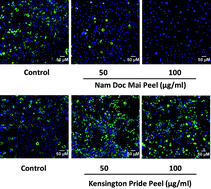Obesity is associated with many chronic disease states, such as diabetes mellitus, coronary disease and certain cancers, including those of the breast and colon. There is a growing body of evidence that links phytochemicals with the inhibition of adipogenesis and protection against obesity. Mangoes (Mangifera indica L.) are tropical fruits that are rich in a diverse array of bioactive phytochemicals. In this study, methanol extracts of peel and flesh from three archetypal mango cultivars; Irwin, Nam Doc Mai and Kensington Pride, were assessed for their effects on a 3T3-L1 pre-adipocyte cell line model of adipogenesis. High content imaging was used to assess: lipid droplets per cell, lipid droplet area per cell, lipid droplet integrated intensity, nuclei count and nuclear area per cell. Mango flesh extracts from the three cultivars did not inhibit adipogenesis; peel extracts from both Irwin and Nam Doc Mai, however, did so with the Nam Doc Mai extract most potent at inhibiting adipogenesis. Peel extract from Kensington Pride promoted adipogenesis. The inhibition of adipogenesis by Irwin (100 μg mL−1) and Nam Doc Mai peel extracts (50 and 100 μg mL−1) was associated with an increase in the average nuclear area per cell; similar effects were seen with resveratrol, suggesting that these extracts may act through pathways similar to resveratrol. These results suggest that differences in the phytochemical composition between mango cultivars may influence their effectiveness in inhibiting adipogenesis, and points to mango fruit peel as a potential source of nutraceuticals.

You have access to this article
 Please wait while we load your content...
Something went wrong. Try again?
Please wait while we load your content...
Something went wrong. Try again?


 Please wait while we load your content...
Please wait while we load your content...